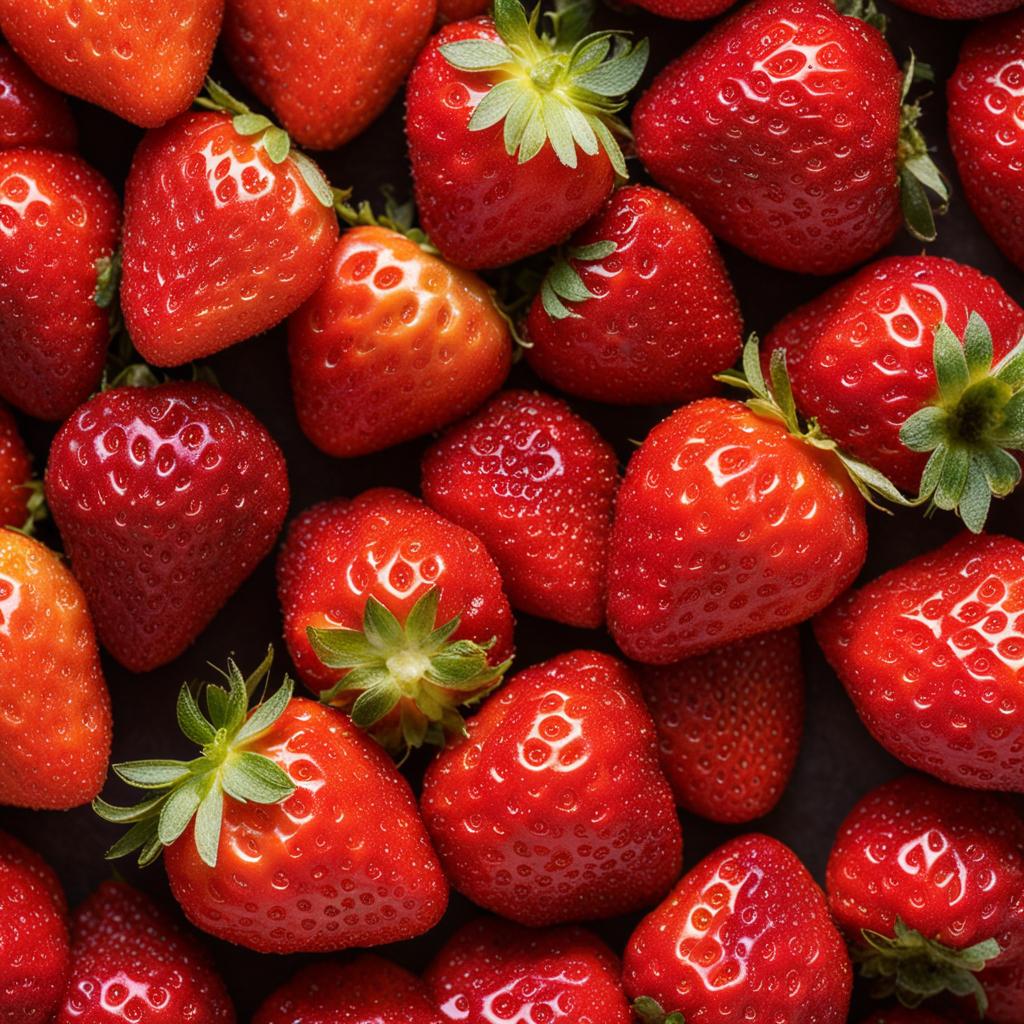Hello, fellow strawberry lovers! There’s nothing quite like the sweet, juicy taste of a fresh strawberry. But how can you tell if those beautiful berries are still good to eat or if they’ve gone bad? Worry not, because I’m here to guide you through the signs of spoilage and share some tips on keeping your strawberries fresh for longer.
When it comes to determining the freshness of strawberries, there are a few key things to look out for. Fresh strawberries should be firm to the touch, have a lovely floral smell, and be free from any mold or squishy areas. It’s important to know the signs of spoilage, which include mold growth, soft spots, discolored leaves, and a strong, acrid smell.
Now, let’s dive deeper into each of these signs and learn how to identify if your strawberries are past their prime and shouldn’t be consumed. But don’t worry, I’ll also share some tips on how to store strawberries properly to maximize their shelf life. Let’s get started!
Key Takeaways:
- Fresh strawberries should be firm, have a pleasant floral smell, and be free from mold or squishy areas.
- Signs of spoilage include mold growth, soft spots, discolored leaves, and a strong, acrid smell.
- Store strawberries in an airtight container in the refrigerator to keep them fresh for longer.
- Remove any spoiled strawberries immediately to prevent them from rotting the other berries.
- Do not consume strawberries with moldy spots, as mold can spread and cause illness.
Signs of Rot in Strawberries
When it comes to determining if strawberries have gone bad, there are several key signs to look out for. These indicators can help you identify if the berries have started to rot and should no longer be consumed. Mold growth is one of the most common signs of strawberry spoilage. Mold can appear as white, dark brown, or black patches on the berries or leaves. If you notice any mold, it’s best to discard the strawberries to avoid any health risks.
Another sign of rot in strawberries is the presence of soft spots. These spots may be darker in color compared to the surrounding fruit. When strawberries start to spoil, the texture becomes mushy and less firm. Discolored leaves, such as yellowing or browning, are also indications that the strawberries are past their prime.
Furthermore, the smell of strawberries can provide valuable information about their freshness. Fresh strawberries have a pleasant, floral scent. However, if you notice an acrid or ammonia-like smell coming from the berries, it’s a clear sign that they have gone bad and should not be consumed.
| Signs of Rot in Strawberries | Description |
|---|---|
| Mold Growth | White, dark brown, or black patches on berries or leaves |
| Soft Spots | Darker, mushy areas on strawberries |
| Discolored Leaves | Yellowing or browning of leaves |
| Unpleasant Smell | Acrid or ammonia-like odor |
By being aware of these signs, you can ensure that you only consume fresh and safe strawberries. It’s important to remember that once strawberries have started to rot, cutting off the affected parts is not recommended. Mold and bacteria can spread beyond what is visible, and consuming spoiled strawberries can lead to adverse health effects. To maintain the quality and freshness of your strawberries, it’s best to store them properly and discard any that show signs of rot.
The Best Way to Store Strawberries
When it comes to storing strawberries, the best way to maintain their freshness and extend their shelf life is by following a few key steps. By storing them in the refrigerator in an airtight container, you can help preserve their flavor and texture for a longer period of time.
One helpful tip is to place a piece of paper towel under unwashed strawberries in the container. This helps absorb moisture and prevents premature molding, keeping the strawberries fresh and ready to enjoy. Additionally, regularly checking for any spoiled berries and removing them promptly can help prevent the spread of mold and preserve the overall quality of the batch.
Another method to consider is giving the strawberries a vinegar wash before storing them. Simply soak the strawberries in a mixture of water and white vinegar for a few minutes, then rinse them thoroughly and allow them to dry before placing them in an airtight container in the refrigerator. This vinegar wash helps remove bacteria and mold, giving the strawberries a longer lifespan of about 3 to 7 days.
| Storage Method | Shelf Life |
|---|---|
| Refrigerator in an airtight container | Up to one week |
| Vinegar wash and refrigeration | About 3 to 7 days |
By following these storage methods, you can ensure that your strawberries stay fresh and delicious for as long as possible. Whether you’re using them for snacking, cooking, or adding them to your favorite recipes, properly storing strawberries is essential for maximizing their enjoyment.
How Long Do Strawberries Keep in the Fridge?
When it comes to storing strawberries, refrigeration is key in maintaining their freshness and extending their shelf life. On average, strawberries can be stored in the fridge for up to one week. However, proper storage techniques and regular inspection are important to ensure their quality.
For optimal freshness, store strawberries in an airtight container in the refrigerator. The cool temperature helps slow down the ripening process and prevents mold growth. To further enhance their shelf life, you can place a paper towel at the bottom of the container to absorb excess moisture, which can cause premature spoilage.
It’s important to remove any spoiled strawberries immediately to prevent them from affecting the rest of the batch. Moldy or soft strawberries should be discarded as they can spread bacteria and mold to the other berries. By practicing regular inspection and prompt removal of any bad strawberries, you can maximize the longevity of your strawberry supply.
Table: Tips for Extending the Shelf Life of Strawberries
| Storage Method | Shelf Life |
|---|---|
| Refrigeration in an airtight container | Up to one week |
| Refrigeration in an airtight container with a paper towel | Potentially longer than one week |
| Freezing | Up to 6 months |
“Proper storage techniques and regular inspection are important to ensure the quality and longevity of strawberries.”
By following these storage tips, you can enjoy fresh and delicious strawberries for an extended period of time. Whether you’re using them in smoothies, salads, or desserts, being able to keep strawberries in the fridge for longer allows you to savor their sweet flavor and reap their health benefits.
Can You Cut the Moldy Spots Off Strawberries?
When you come across moldy spots on strawberries, it may be tempting to simply cut them off and consume the rest of the fruit. However, it is important to prioritize safety and understand that cutting moldy spots off strawberries is not recommended.
Mold is a type of fungus that can spread beyond the visible patches. Even if you remove the moldy areas, there is a high chance that the fungus has already penetrated deeper into the fruit. Consuming moldy strawberries can lead to health risks and potential illness.
To ensure your well-being, it is best to discard strawberries with any signs of mold. This way, you can enjoy fresh and safe strawberries without compromising your health.
| Scenario | Safety |
|---|---|
| Cutting off moldy spots and consuming the rest | Not safe |
| Discarding moldy strawberries | Safe |
By following proper safety guidelines and being aware of the risks, you can make informed decisions when it comes to consuming strawberries. Remember, when in doubt, it is always better to err on the side of caution and prioritize your health.
Do You Need to Store Strawberries in the Fridge?
When it comes to storing strawberries, many people wonder if they really need to keep them in the fridge. The answer depends on how quickly you plan to consume them. If you’re going to eat the strawberries the same day you buy them, it’s safe to keep them at room temperature. However, if you want to extend their shelf life and keep them fresh for longer, refrigeration is recommended.
Storing strawberries in the fridge helps maintain their freshness and prevents spoilage. The cool temperature slows down the ripening process and inhibits the growth of mold and bacteria. If left at room temperature for too long, strawberries can become soft, mushy, and prone to mold growth. By refrigerating them, you can enjoy their sweet, juicy flavor for a longer period of time.
It’s important to note that once strawberries are cut, they should be refrigerated within two hours to prevent bacterial growth. Cut strawberries have a higher risk of spoilage due to their exposed surface area. By storing them in the fridge, you can reduce the growth of bacteria and keep them safe to eat for a few more days.
Benefits of Refrigeration for Strawberries:
- Preserves freshness and flavor
- Prevents mold growth
- Reduces the risk of bacterial contamination
- Extends shelf life
In summary, although it’s possible to keep strawberries at room temperature, refrigeration is recommended for longer storage. The cool temperature of the fridge helps maintain their freshness, prevents spoilage, and extends their shelf life. Whether you’re planning to enjoy them on the same day or want to savor them for a few more days, refrigerating strawberries is a simple yet effective way to keep them at their best.
Are Strawberries with a Bad Smell Okay to Eat?
When it comes to strawberries, a bad smell is a clear indication that something isn’t right. Fresh strawberries should have a pleasant, floral scent, enticing you with their natural sweetness. However, if you notice an acrid or sour smell coming from your strawberries, it’s best to avoid consuming them. The strong odor is a sign that the strawberries have gone bad and may not taste good.
Bad smells in strawberries can be a result of spoilage. As strawberries decay, they release ethylene gas, which speeds up the spoilage process and leads to an unpleasant aroma. It’s important to trust your sense of smell when determining the freshness of strawberries and to prioritize your safety when it comes to consuming them. Remember, it’s always better to be safe than sorry!
“Fresh strawberries should have a pleasant, floral scent, enticing you with their natural sweetness.”
To ensure you’re enjoying fresh and delicious strawberries, it’s crucial to practice proper storage techniques. Storing strawberries in an airtight container in the refrigerator can help maintain their freshness. Additionally, regularly check your strawberries for any signs of spoilage, including mold growth, soft spots, discoloration, and, of course, a bad smell. Removing any spoiled berries immediately can prevent them from further spoiling the rest of the batch.
The importance of a good sniffer!
Your sense of smell plays a vital role in determining the quality and safety of the strawberries you consume. Trusting your sense of smell can help you avoid potentially harmful berries and ensure you’re enjoying the best strawberries possible. So, if you come across strawberries with a bad smell, it’s best to play it safe and say goodbye to those berries.
| Signs of Bad Strawberries | What to Do |
|---|---|
| Mold growth | Discard the strawberries immediately |
| Soft spots | Avoid consuming the strawberries |
| Discolored leaves | Inspect the strawberries further for signs of spoilage |
| Acrid or sour smell | Do not eat the strawberries |
Remember, fresh strawberries should have a delightful aroma that makes your mouth water. If the smell is anything less than appetizing, it’s best to opt for fresh strawberries that will provide a delicious and enjoyable eating experience. Trust your nose, and enjoy the sweet, fresh taste of strawberries at their best!

How Long Do Cut Strawberries Last?
When it comes to cut strawberries, their shelf life depends on proper storage. If refrigerated in an airtight container, cut strawberries can last up to 4 days. It’s important to keep them chilled at a temperature below 40°F (4°C) to slow down the growth of bacteria and preserve their freshness. Storing them in the coldest part of the refrigerator, such as the back of the bottom shelf, can help maintain their quality for a longer period.
However, if you’re looking for even longer storage, freezing is an option. Frozen cut strawberries can last up to 6 months if stored in a freezer-safe bag or container. Freezing can alter the texture of the strawberries, making them softer and better suited for use in smoothies, ice cream, or baked goods. So, before freezing, consider how you plan to use them in your recipes.
It’s worth noting that the quality of cut strawberries may deteriorate over time, especially in terms of texture. Before consuming frozen strawberries, it’s a good idea to thaw them in the refrigerator overnight or by running them under cold water. This will help restore some of their texture and maintain the best flavor possible.
The Shelf Life of Cut Strawberries:
| Storage Method | Shelf Life |
|---|---|
| Refrigeration (in an airtight container) | Up to 4 days |
| Freezing (in a freezer-safe bag or container) | Up to 6 months |
By following proper storage guidelines, you can enjoy the delicious taste of cut strawberries for an extended period. Whether you decide to refrigerate or freeze them, make sure to label and date the container to keep track of their freshness. Happy strawberry snacking and cooking!
Can You Freeze Strawberries?
Yes, you can freeze strawberries to extend their shelf life and enjoy them later. Freezing strawberries is a simple and convenient way to preserve their freshness and flavor. However, it’s important to keep in mind that freezing can affect the texture of strawberries, making them better suited for certain culinary uses like smoothies, ice cream, and baked goods.
To freeze strawberries, start by washing and drying them thoroughly. Remove the stems and any blemishes before placing the berries on a baking sheet lined with parchment paper. Make sure the berries are spaced out and not touching each other. This will prevent them from freezing together into a solid mass.
Once the strawberries are frozen solid, transfer them to an airtight container or freezer bag. Remember to label the container with the date to keep track of their freezer life. Frozen strawberries can be stored for up to 6 months.
Identifying Bad Strawberries: Key Signs to Watch For
When it comes to strawberries, freshness is key. To ensure that you’re enjoying the sweetest and most delicious strawberries, it’s important to be able to identify when they have gone bad. By understanding the key signs of spoilage, you can confidently pick out the best strawberries for your enjoyment.
One of the most noticeable signs of bad strawberries is mold growth. Mold appears as white, blue, or green patches on the surface of the berries or leaves. If you spot any mold on your strawberries, it’s best to discard them immediately.
Discoloration is another indicator of spoilage. Dark or brown spots on the strawberries can mean that they are no longer fresh. Additionally, if you notice any off smells, such as an acrid or sour odor, it’s a clear sign that the strawberries have gone bad.
Texture changes, such as softness or mushiness, can also indicate spoilage. If the strawberries feel too soft or mushy to the touch, it’s best to avoid consuming them. These texture changes are often accompanied by an unpleasant taste.
By keeping an eye out for these key signs of spoilage, you can enjoy the freshest and most delicious strawberries every time. Remember to discard any strawberries that show these signs to ensure your safety and enjoyment.
Table: Key Signs of Bad Strawberries
| Signs of Spoilage | Description |
|---|---|
| Mold Growth | White, blue, or green patches on the berries or leaves. |
| Discoloration | Dark or brown spots on the strawberries. |
| Off Smell | Acrid or sour odor. |
| Texture Changes | Softness or mushiness. |
Mold Growth
When it comes to strawberries, mold growth is a clear indication of spoilage. Mold is a type of fungus that can thrive on the surface of strawberries, leading to their deterioration. It appears as white, dark brown, or black patches on the berries or leaves. Mold can spread rapidly, so it’s important to discard strawberries with any signs of mold to prevent further contamination.
Mold growth on strawberries is a result of various factors such as improper storage, exposure to moisture, and extended shelf life. The presence of mold indicates that the strawberries have reached a point where they are no longer safe for consumption. Mold not only affects the appearance of the strawberries but also compromises their taste and texture.
To prevent mold growth and extend the freshness of strawberries, proper storage is crucial. Storing strawberries in an airtight container in the refrigerator helps maintain their quality and minimizes the risk of mold development. Regularly checking for any signs of mold and removing spoiled berries promptly can help preserve the overall freshness of the batch.
| Signs of Mold Growth on Strawberries | Action to Take |
|---|---|
| White, dark brown, or black patches on berries | Discard the affected strawberries |
| Visible mold on leaves | Remove affected leaves and inspect berries |
| Strong musty smell | Inspect berries and discard if necessary |
Being aware of the signs of mold growth on strawberries is essential for ensuring food safety. By properly storing and regularly checking your strawberries, you can enjoy them at their freshest, free from any spoilage or potential health risks.
Discoloration
Discoloration in strawberries is a common sign of spoilage and can be caused by various factors such as lack of ripeness, inadequate storage, or prolonged storage leading to decomposition. Recognizing discoloration is crucial in identifying whether strawberries are still fresh or have gone bad.
When strawberries are not fully ripe, they may exhibit dark or brown spots, indicating that they were picked prematurely. In this case, the strawberries may still be safe to consume but may not taste as sweet or flavorful as fully ripe ones. However, if the discoloration is accompanied by other signs of spoilage, it is best to err on the side of caution and discard the strawberries.
Inadequate storage can also contribute to discoloration in strawberries. Exposure to direct sunlight or high temperatures can cause the fruit to darken or develop brown spots. To prevent discoloration, it is important to store strawberries in a cool, dry place away from sunlight. Refrigeration in an airtight container can help maintain the freshness of strawberries and slow down the process of discoloration.
Table: Comparing Causes of Strawberry Discoloration
| Cause | Description |
|---|---|
| Lack of Ripeness | Strawberries picked before fully ripening may develop dark or brown spots. |
| Inadequate Storage | Exposure to sunlight or high temperatures can cause strawberries to darken or develop brown spots. |
| Prolonged Storage | Strawberries stored for an extended period may decompose, resulting in discoloration. |
While some discoloration in strawberries may still be safe to consume, it is best to use visual cues and other signs of spoilage to determine if the strawberries are bad. If the discoloration is accompanied by mold growth, an off smell, or a mushy texture, it is a clear indication that the strawberries have gone bad and should be discarded. Regularly checking for and removing any spoiled strawberries can help prevent the spread of spoilage and ensure a fresh and enjoyable strawberry experience.
Off Smell
One of the key indicators of freshness and spoilage in strawberries is the presence of an off smell. When strawberries start to go bad, they release a compound called ethylene gas, which speeds up the spoilage process and gives rise to a distinct and unpleasant odor. If you come across a strawberry that has a bitter or sour smell, it is best to discard it to avoid any potential health risks.
The off smell in strawberries can be attributed to the breakdown of organic compounds and the growth of bacteria or mold. As the fruit deteriorates, the production of volatile compounds increases, creating an aroma that is far from the fresh and sweet scent of ripe strawberries. Trust your sense of smell and rely on the freshness of the strawberries to determine whether they are safe to eat or not.
Remember, freshness is key when it comes to strawberries, and an off smell is a sure sign that the fruit has surpassed its prime. To ensure you enjoy the best strawberries possible, always check for any unpleasant odors and discard any berries that have a noticeable off smell.
Texture Changes: Soft and Mushy Strawberries
When it comes to determining the freshness of strawberries, paying attention to texture changes is crucial. Softness and mushiness are clear indicators that the strawberries are in the process of spoiling. These changes in texture are often accompanied by decomposition, which can be caused by the presence of bacteria or mold.
Soft strawberries are a result of the breakdown of cell walls within the fruit. As the strawberries age, enzymes and microorganisms break down the pectin that holds the cells together, resulting in a softer, less firm texture. Mushy strawberries, on the other hand, have advanced beyond the soft stage and have become squishy and watery.
It’s important to note that consuming soft or mushy strawberries not only compromises their taste and texture but can also pose health risks. The decomposition process in these strawberries can lead to the growth of harmful bacteria and mold, which may cause foodborne illnesses. To ensure your safety and enjoyment, it’s best to discard any strawberries that have become excessively soft or mushy.

Quote:
“Soft strawberries are a result of the breakdown of cell walls within the fruit. Mushy strawberries have advanced beyond the soft stage and have become squishy and watery.”
Storing Strawberries: Tips for Longer Shelf Life
Proper storage is essential for ensuring the longevity and freshness of strawberries. Here are some helpful tips to help you maximize the shelf life of your strawberries:
- Refrigerator: Storing strawberries in the refrigerator is key to preserving their freshness. The cool temperature of the fridge slows down the ripening process and helps prevent spoilage.
- Airtight container: Place your strawberries in an airtight container to protect them from moisture and air exposure. This will help maintain their crispness and prevent them from getting mushy.
- Paper towel: To prevent excess moisture and premature molding, consider placing a paper towel at the bottom of the container. The paper towel will absorb any moisture and keep your strawberries in optimal condition.
Regularly inspect your strawberries and remove any spoiled or moldy berries immediately to prevent the spread of decay. By following these storage tips, you can enjoy your strawberries for a longer period and savor their delicious flavors.
Table: Comparing Different Storage Methods for Strawberries
| Storage Method | Shelf Life | Advantages | Disadvantages |
|---|---|---|---|
| Refrigerator in an airtight container | Up to one week |
|
|
| Room temperature | Only lasts for a day |
|
|
| Freezing | Up to 6 months |
|
|
By comparing different storage methods, you can make an informed decision on how to store your strawberries based on your specific needs and preferences.
Conclusion
In conclusion, understanding how to tell if strawberries are bad is crucial for ensuring the consumption of fresh and safe fruit. By being aware of the signs of spoilage, such as mold growth, soft spots, discoloration, and off smells, you can easily determine the quality of strawberries before consuming them.
Proper storage plays a key role in maintaining the freshness and extending the shelf life of strawberries. Storing them in an airtight container in the refrigerator helps preserve their taste and texture. Additionally, placing a paper towel under unwashed strawberries can absorb excess moisture, preventing premature molding.
Regularly checking for any spoiled berries and removing them promptly will further prolong the overall freshness of your strawberries. And if you want to enjoy strawberries even beyond their peak, freezing them in a proper airtight container can keep them fresh for up to 6 months.
So, whether you prefer eating strawberries fresh or using them in various recipes, knowing how to identify bad strawberries and following proper storage techniques will ensure that you get the best out of these delicious and nutritious fruits. Enjoy your strawberries while they are at their peak!
FAQ
How can I tell if strawberries are bad?
Signs of bad strawberries include mold growth, soft spots, discolored leaves, and a strong, acrid smell. If any of these are present, it’s best to discard the strawberries.
What are the signs of rot in strawberries?
Mold growth, soft spots, discolored leaves, and a strong, acrid smell are all signs that strawberries have gone bad.
What is the best way to store strawberries?
To keep strawberries fresh, store them in an airtight container in the refrigerator. You can also give them a vinegar wash before storing to remove bacteria and mold.
How long do strawberries keep in the fridge?
Strawberries typically keep for up to one week in the refrigerator. Proper refrigeration helps maintain their freshness and prevents spoilage.
Can you cut the moldy spots off strawberries?
It is not safe to cut moldy spots off strawberries and consume the rest of the fruit. Mold can spread beyond what is visible, so it’s best to discard strawberries with mold.
Do you need to store strawberries in the fridge?
While it is safe to keep strawberries at room temperature if they will be consumed the same day, it is recommended to store them in the refrigerator for longer storage. Refrigeration helps maintain their freshness and prevents spoilage.
Are strawberries with a bad smell okay to eat?
Strawberries with an acrid or sour smell should not be eaten. A strong smell is an indication that the strawberries have gone bad and may not taste good.
How long do cut strawberries last?
Cut strawberries can be refrigerated in an airtight container for up to 4 days. For longer storage, they can be frozen in a freezer-safe bag for up to 6 months.
Can you freeze strawberries?
Yes, strawberries can be frozen. Proper storage in an airtight container can keep frozen strawberries fresh for up to 6 months. However, their texture may change after being frozen.
What are the key signs to watch for in identifying bad strawberries?
Key signs of bad strawberries include mold growth, discoloration, off smell, and texture changes such as softness and mushiness.
What causes mold growth on strawberries?
Mold growth on strawberries is caused by the presence of fungus. Mold can appear as white, dark brown, or black patches on the surface of the berries or leaves.
What causes discoloration in strawberries?
Discoloration in strawberries can be caused by a lack of ripeness, inadequate storage, or prolonged storage leading to decomposition.
Why do bad strawberries have an off smell?
As strawberries decay, they release ethylene gas, which speeds up the spoilage process and results in a bad smell.
What do soft and mushy strawberries indicate?
Soft and mushy strawberries indicate decomposition and the presence of bacteria or mold. It is best to discard them to avoid any health risks.
How can I store strawberries for longer shelf life?
To extend the shelf life of strawberries, store them in an airtight container in the refrigerator. Placing a paper towel under unwashed strawberries can absorb excess moisture and prevent premature molding. Regularly check for and remove any spoiled strawberries to help prolong the overall freshness of the batch.
Can I consume strawberries with mold?
It is not safe to consume strawberries with mold, as mold can spread beyond what is visible. To ensure safety, it is best to discard strawberries with mold.
Source Links
- https://www.doesitgobad.com/do-strawberries-go-bad/
- https://thishealthytable.com/blog/strawberries-gone-bad/
- https://upickfarmsusa.com/how-to-tell-if-strawberries-are-bad/
Related Recipes:
 Strawberry Storage: Keeping Berries Fresh
Strawberry Storage: Keeping Berries Fresh
 How to Store Berries and Keep Them Fresh
How to Store Berries and Keep Them Fresh
 How to Tell if Cauliflower is Past Its Prime
How to Tell if Cauliflower is Past Its Prime
 Spotting Bad Lemons: What to Look For
Spotting Bad Lemons: What to Look For
 How to Tell if Limes Are Bad: Spotting Spoilage
How to Tell if Limes Are Bad: Spotting Spoilage
 Does Almond Milk Go Bad? How to Tell and Storage Tips.
Does Almond Milk Go Bad? How to Tell and Storage Tips.
 How to Tell if Jelly Has Gone Bad: Preserving Quality
How to Tell if Jelly Has Gone Bad: Preserving Quality
 How to Tell if Raspberries Are Bad: Freshness Facts
How to Tell if Raspberries Are Bad: Freshness Facts








